Hava Cloud Diagrams for Troubleshooting and Maintenance
Troubleshooting cloud computing issues can be time consuming and complex. Here's how Hava can help.
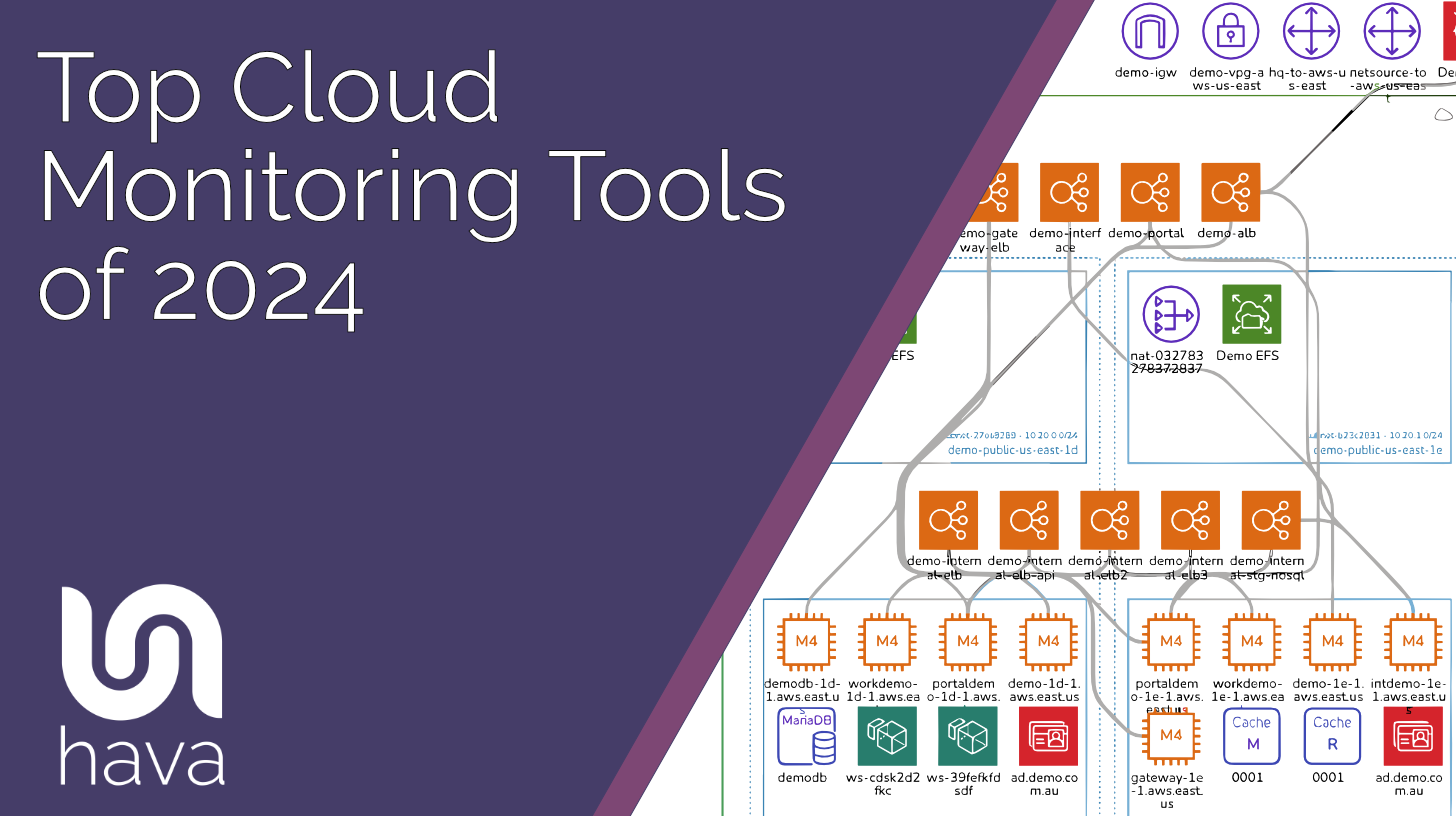
Selecting a cloud monitoring tool is a decision that can dictate the efficiency and security of your entire IT operations. This article serves as your guide to understanding and choosing from the top cloud monitoring tools of 2024, ensuring you have the insights to enhance your cloud infrastructure’s performance and security.
Cloud monitoring is essential for managing and optimizing IT infrastructures in the cloud, ensuring high availability, performance and proactive issue resolution while optimizing resource allocation.
A comprehensive cloud infrastructure monitoring includes real-time analytics, machine learning for predictive analysis and automation, and effective multi-cloud management systems to ensure security, compliance, and performance across diverse cloud services.
The selection of an appropriate cloud monitoring tool is critical, influenced by factors such as scalability, integration capability and pricing, with tools like LogicMonitor, New Relic, and others offering customizable, feature-rich platforms for diverse business needs.
How you can bring context to findings by visualising the architecture resources in your observability platform using Hava.
How you can bypass complex monitoring solutions by leveraging Hava's built in architecture monitoring.
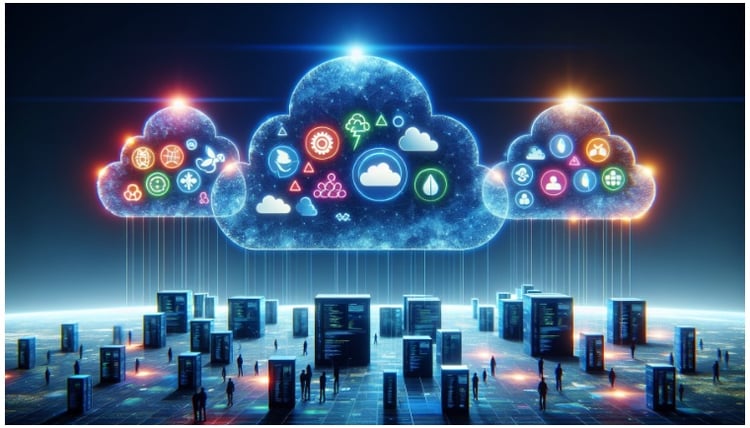
Cloud monitoring involves:
Assessing and managing cloud-based IT infrastructures and services
Overseeing the availability and performance of cloud environments
Proactively identifying potential issues and resolving them promptly
Maintaining the health of cloud systems
Ensuring a smooth end-user experience
Not only does it monitor the well-being of cloud servers and services, but it also plays a significant role in optimizing resource allocation. Systematic analysis of performance metrics allows the detection of bottlenecks and adjustment of resource allocation relative to workload demands, thus guaranteeing optimal performance for cloud apps and services.

Given the multitude of cloud monitoring tools available in 2024, identifying the right one might seem daunting. The best cloud monitoring tools offer a wide array of features to meet diverse business needs, including:
Open-source and enterprise-grade platforms
Insights on different resource types
Integrated alert systems for significant issues or anomalies in the cloud infrastructure
These tools are not just one-size-fits-all solutions. They cater to the varying needs of businesses through customizable options, support for different resource types, and integrated notification systems to alert on any identifiable issues, ensuring businesses of all sizes and types can discover a suitable monitoring solution for their distinct cloud environments.
For instance, LogicMonitor and New Relic are recognized for their ease of setup and usage, efficient alerting system, and expansive monitoring coverage.

Comprehensive cloud infrastructure monitoring is an essential aspect of maintaining effective cloud-based operations. It involves the utilization of software tools to visually represent and monitor the performance of cloud applications and services. This offers a real-time overview of the entire cloud infrastructure, including:
Servers
Storage
Networking components
Overall performance
Security
Reliability
Cost
Let’s explore in more detail its three main elements: real-time analytics, machine learning integration, and multi-cloud management.
Real-time analytics holds significant importance in cloud infrastructure monitoring. It enables teams to:
Anticipate, avert, or promptly identify failing components, service spikes, and security threats
Gain instantaneous understanding of infrastructure issues
Facilitate swift resolution, thereby reducing potential impacts on customers and business operations.
Moreover, real-time analytics contribute to optimizing the performance of cloud services by offering rapid insights into network performance, expediting decision-making and operations, and enabling agile responses to performance issues. Tools such as DigitalOcean Monitoring and Google Operations are examples of solutions that offer real-time analytics, helping businesses identify anomalies, performance issues, and critical events swiftly, ensuring a rapid response and resolution.
The integration of machine learning into cloud infrastructure monitoring presents numerous advantages, including:
Automating complex processes
Optimizing resource allocation
Improving interoperability between different cloud services
Providing predictive analytics
Enabling proactive issue resolution
These benefits are crucial for modern, dynamic cloud environments.
Machine learning contributes to resource optimization in the cloud through proactive management, predicting potential hardware failures, and enhancing the overall efficiency of the cloud environment. The functionality of predictive analytics in machine learning-integrated cloud monitoring leverages data, statistics, and machine learning techniques to anticipate and strategically prepare for upcoming events, thereby enabling a proactive approach to cloud management.
In our progressively interconnected society, numerous businesses function in hybrid or multi-cloud environments. Multi-cloud management is essential in comprehensive cloud infrastructure monitoring as it enables organizations to effectively oversee and monitor distributed workloads and applications across various cloud services or providers.
Cloud monitoring tools provide the following benefits for managing multi-cloud environments:
Centralized visibility and control over the cloud ecosystem
Comprehensive understanding of performance, health, and resource usage
Seamless monitoring of multiple cloud platforms
Real-time data collection
Flexible data collection mechanisms
Assistance in regaining control over cloud spending
These tools are essential for maintaining a comprehensive understanding of performance, health, and resource usage in a diverse cloud environment.
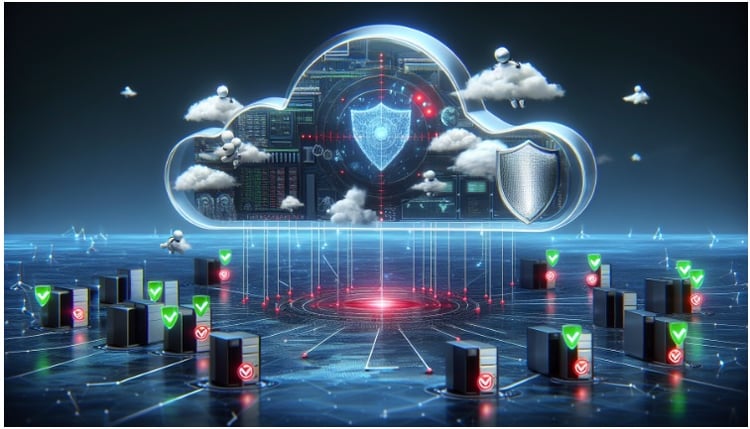
As cyber threats escalate, security has emerged as a primary concern for businesses utilizing the cloud. Security-focused cloud monitoring solutions enhance the security of cloud applications and networks, playing a crucial role in identifying and addressing security threats and ensuring adherence to regulations.
Let’s further explore two crucial elements: threat detection and response, and compliance assurance.
Cloud monitoring tools with threat detection and response capabilities play a crucial role in protecting cloud infrastructure from potential security breaches and cyberattacks. They:
Maintain continuous surveillance of cloud environments
Conduct thorough analysis of data to identify potential threats and vulnerabilities
Promptly address attacks as they occur in real-time
Tools like Microsoft Azure Sentinel and Google Cloud Armor are notable examples of cloud monitoring tools with robust threat detection and response capabilities. They demonstrate effectiveness in mitigating security breaches and cyberattacks through the facilitation of regular monitoring and auditing of cloud-based systems. They offer:
Real-time detection of security incidents
Insights for enhancing security controls
Reviewing access logs
Monitoring network traffic
Conducting vulnerability scans
These capabilities help ensure the security of your cloud-based systems.
Compliance assurance in cloud monitoring encompasses efforts made to uphold compliance requirements, policies, and procedures. Cloud monitoring tools guarantee compliance with industry regulations and standards by comprehending the compliance requirements, implementing strong security measures, and establishing effective governance and risk management practices.
Ensuring compliance with data protection, security, and privacy requirements is crucial. Industry regulations and standards such as HIPAA, PCI DSS, GDPR, ISO/IEC 27001, NIST, NERC, and Sarbanes-Oxley (SOX) play a pivotal role in this. Compliance assurance in cloud monitoring contributes to reducing reputational damage by optimizing costs, instilling confidence in compliance programs, minimizing risk, and ensuring data insurance and security affirmation.
Tools like Hava capture the state of your architecture every time it changes which provides the data needed by auditors when they need to know what has changed since the last successful compliance audit.

Performance is a key facet of all cloud environments. We will now investigate the contributions of application performance management and server monitoring capabilities to the optimization of cloud performance and user experience.
Application performance management (APM) in cloud monitoring is the practice of monitoring resources that contribute to the performance of software applications in the public cloud. It broadens observability beyond system availability and service performance, aiding organizations in enhancing user experiences within the context of modern computing.
APM enhances user satisfaction in cloud environments by identifying and addressing issues in the application, highlighting common problems, and identifying areas that deliver maximum value to end users. Cloud monitoring tools leverage APM to monitor and analyze synthetic traffic, identify limitations and errors, ensure system availability, optimize service performance and response times, and enhance user experiences.
Server monitoring capabilities in cloud monitoring tools encompass:
The capacity to monitor on-premises, cloud, or hybrid app environments and infrastructure
Providing observability with metrics accessible within resource pages
SLO monitoring
The ability to measure and manage workloads inside cloud tenancies against specific metrics.
Server monitoring capabilities play a crucial role in maintaining the health and performance of physical and virtual servers by analyzing real-time and historical data to detect performance issues and anticipate potential crashes.
Cloud monitoring tools such as DigitalOcean Monitoring and AWS CloudWatch demonstrate strong server monitoring capabilities, including monitoring cloud apps, and help in predicting potential issues, monitoring response time, availability, and resource usage, ensuring consistent high performance and enabling seamless digital workflows.
Cloud monitoring need not be prohibitively expensive. There are cost-effective strategies that businesses can implement to maximize the return on their investment and minimize unnecessary expenses. These strategies include:
Opting for reserved or spot instances to save costs
Conducting thorough capacity planning to align resources with demand
Optimizing data flows and service locations to limit data transfer fees
Conducting regular audits of cloud resources to prevent cloud sprawl and avoid paying for unused services.
Nonetheless, challenges related to cost are present. These include a lack of visibility into spending practices, hidden costs due to inadequate monitoring tools, misinterpretation of cost reports, and the ongoing maintenance and updates required for cost management tools. To address these challenges, it is important to ensure clear visibility and understanding of spending, select appropriate cost management and monitoring tools, accurately interpret cost reports to make informed decisions, and prepare for the maintenance and updates of tools.
Additionally, to achieve a balance between cost and performance, it is important to:
Examine workloads to identify over-provisioning
Rightsizing resources to fit actual needs
Carefully select the right pricing model that aligns with the specific usage patterns and requirements of the cloud service.
Use Hava to scan your entire cloud account to surface every running resource, this often shines a light on long forgotten instances that can be terminated.
In cloud monitoring, data insights are instrumental in reducing the risks of errors and inaccurate analytics, guaranteeing data accuracy and quality, and enhancing overall performance. Businesses can utilize data insights to recognize patterns and trends, comprehend customer behavior, make well-informed decisions, and attain a competitive advantage.
Cloud monitoring tools offer the following data insights for effective cloud operations:
Measurement and management of workloads against specific metrics
Analysis of data to identify trends and patterns
Ability to address critical questions about system performance, usage, and health
Advanced monitoring data enhances the capabilities of IT operations teams by offering real-time insights into system performance, thereby facilitating informed decision-making. Additionally, it aids in early detection of potential issues, thereby reducing downtime and ensuring the smooth continuity of business operations.
Selecting an appropriate cloud monitoring tool is vital to guarantee the optimal performance and security of your cloud environment. Factors such as scalability, integration with existing systems, and pricing can greatly impact your choice of cloud monitoring tool.
Scalability ensures consistent high-performance levels and reliability, even during heavy usage periods. Integration with existing systems plays a vital role in ensuring system efficiency, data security, cloud cost optimization, and overall business success.
To assess the pricing of cloud monitoring tools, you can generate reports and filter them by services to understand the costs associated with cloud monitoring, or use a pricing calculator provided by some cloud monitoring tool providers to estimate the costs based on the number of virtual machines and metrics you require.
Selecting the ideal cloud monitoring solution from a wide range of possibilities can pose a challenge. Each cloud services tool offers distinct features, pricing, and capabilities, making the selection process complex.
However, by taking into account factors such as the features offered, ease of use, scalability, pricing, integration capabilities, and customer reviews, businesses can effectively compare different cloud monitoring solutions and make an informed decision. Some of the highly rated monitoring solutions to consider are:

Datadog is a cloud monitoring as a service (CMaaS) platform that provides real-time observability of your entire technology stack. It allows you to monitor, optimize, and investigate app performance, identify potential threats to your systems in real time, analyze network traffic patterns across your cloud environments, and proactively monitor critical application features using AI-driven synthetic monitoring. Datadog enables you to combine and monitor data from all of your environments into one unified platform, reducing blind spots and encouraging cross-team collaboration
Datadog’s platform is trusted by thousands of customers worldwide, including highly experienced mountaineers. The company’s unified observability accelerates business results and improves the performance and security of online customer experiences 1. Datadog’s state-of-the-art infrastructure provides an overview of your system’s performance, from high-level overviews to deep details, fast
Datadog’s cloud security management provides cloud-native security monitoring and threat detection for your cloud environments. The platform integrates and automates infrastructure monitoring, application performance monitoring, and log management to provide unified, real-time observability of your entire technology stack
Amazon CloudWatch is a cloud monitoring service that provides real-time monitoring and observability of your entire technology stack. It is designed for DevOps engineers, developers, site reliability engineers (SREs), IT managers, and product owners. The platform allows you to collect and track metrics, monitor log files, set alarms, and automatically react to changes in your Amazon Web Services (AWS) resources Amazon CloudWatch provides end-to-end observability, automation, and integration with more than 70 AWS services, making it easy to operate efficiently and improve operational performance.
Amazon CloudWatch’s infrastructure monitoring provides a comprehensive view of your system’s performance, from high-level overviews to deep details, fast. The platform’s application performance monitoring (APM) tool allows you to monitor applications, optimize resource use, and respond to performance changes in real time. Amazon CloudWatch also provides cloud-native security monitoring and threat detection for your cloud environments.
The platform’s log management feature enables you to collect, access, and analyze your resource and application data using powerful visualization tools. Amazon CloudWatch’s network monitoring feature allows you to analyze network traffic patterns across your cloud environments. The platform’s synthetic monitoring feature uses AI-driven technology to proactively monitor critical application features.
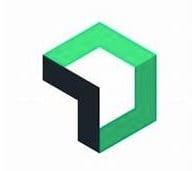
New Relic is a cloud monitoring platform that provides real-time monitoring and observability of your entire technology stack. It is trusted by thousands of customers worldwide and offers a range of features, including infrastructure monitoring, application performance monitoring, log management, network monitoring, synthetic monitoring, and real user monitoring.
New Relic’s platform is designed to help you optimize your system’s performance, improve security, and accelerate business results. The platform provides a comprehensive view of your system’s performance, from high-level overviews to deep details, fast. New Relic’s infrastructure monitoring feature allows you to quickly pinpoint issues across cloud and on-prem infrastructure, APM, and the rest of your stack in one view at a fraction of the cost. The platform’s application performance monitoring (APM) tool allows you to monitor applications, optimize resource use, and respond to performance changes in real time. New Relic also provides cloud-native security monitoring and threat detection for your cloud environments.
The platform’s log management feature enables you to collect, access, and analyze your resource and application data using powerful visualization tools. New Relic’s network monitoring feature allows you to analyze network traffic patterns across your cloud environments. The platform’s synthetic monitoring feature uses AI-driven technology to proactively monitor critical application features.
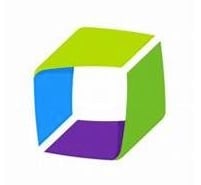
Dynatrace is a cloud monitoring platform that provides real-time monitoring and observability of your entire technology stack. It is trusted by thousands of customers worldwide and offers a range of features, including infrastructure monitoring, application performance monitoring, log management, network monitoring, synthetic monitoring, and real user monitoring.
Dynatrace’s platform is designed to help you optimize your system’s performance, improve security, and accelerate business results. The platform provides a comprehensive view of your system’s performance, from high-level overviews to deep details, fast. Dynatrace’s infrastructure monitoring feature allows you to quickly pinpoint issues across cloud and on-prem infrastructure, APM, and the rest of your stack in one view at a fraction of the cost. The platform’s application performance monitoring (APM) tool allows you to monitor applications, optimize resource use, and respond to performance changes in real time. Dynatrace also provides cloud-native security monitoring and threat detection for your cloud environments.
The platform’s log management feature enables you to collect, access, and analyze your resource and application data using powerful visualization tools. Dynatrace’s network monitoring feature allows you to analyze network traffic patterns across your cloud environments. The platform’s synthetic monitoring feature uses AI-driven technology to proactively monitor critical application features 1.
Site24x7 is a cloud monitoring platform that provides real-time monitoring and observability of your entire technology stack. It is trusted by thousands of customers worldwide and offers a range of features, including infrastructure monitoring, application performance monitoring, log management, network monitoring, synthetic monitoring, and real user monitoring.
Site24x7’s platform is designed to help you optimize your system’s performance, improve security, and accelerate business results. The platform provides a comprehensive view of your system’s performance, from high-level overviews to deep details, fast. Site24x7’s infrastructure monitoring feature allows you to quickly pinpoint issues across cloud and on-prem infrastructure, APM, and the rest of your stack in one view at a fraction of the cost. The platform’s application performance monitoring (APM) tool allows you to monitor applications, optimize resource use, and respond to performance changes in real time 1. Site24x7 also provides cloud-native security monitoring and threat detection for your cloud environments.
The platform’s log management feature enables you to collect, access, and analyze your resource and application data using powerful visualization tools. Site24x7’s network monitoring feature allows you to analyze network traffic patterns across your cloud environments. The platform’s synthetic monitoring feature uses AI-driven technology to proactively monitor critical application features.
Advanced monitoring data, derived from cloud monitoring tools, can equip IT operations teams to proactively manage and optimize cloud resources, thereby guaranteeing optimal performance and user experience. The most beneficial types of data for optimizing cloud resources are:
Performance data
Security data
Reliability data
Cost data
Cloud monitoring tools contribute to proactive management of cloud resources by providing real-time analytics for troubleshooting, enhancing security, and optimizing resource allocation. Advanced monitoring data plays a crucial role in ensuring optimal performance of cloud resources by facilitating strategic decision-making, efficient resource allocation, load balancing, and auto-scaling, as well as offering valuable insights into user experience.
While cloud observability and monitoring applications tell you when problems occur, to really understand the nature of an issue it helps to have some visual context around the cloud resources being reported.
That is where Hava.io comes into play. Whether your infrastructure is hosted on AWS, Microsoft Azure or Google Cloud Platform when your observability tools point to a problem, you can pull up the environment involved and see the offending resource in full context. You can:
See where it is running
See what it is connected to
See the security groups controlling access
See the estimated cloud costs
See changes as they occur
Compare infrastructure between any two dates
By connecting Hava to your cloud accounts, you can build up an audit trail of architecture changes and always have up to data architecture and security diagrams on hand which includes container monitoring.
If you just need a simple alert notification whenever your cloud architecture changes without the need for a complex and separate observability platform, then Hava has you covered (no log data sifting required to keep on top of your cloud components).
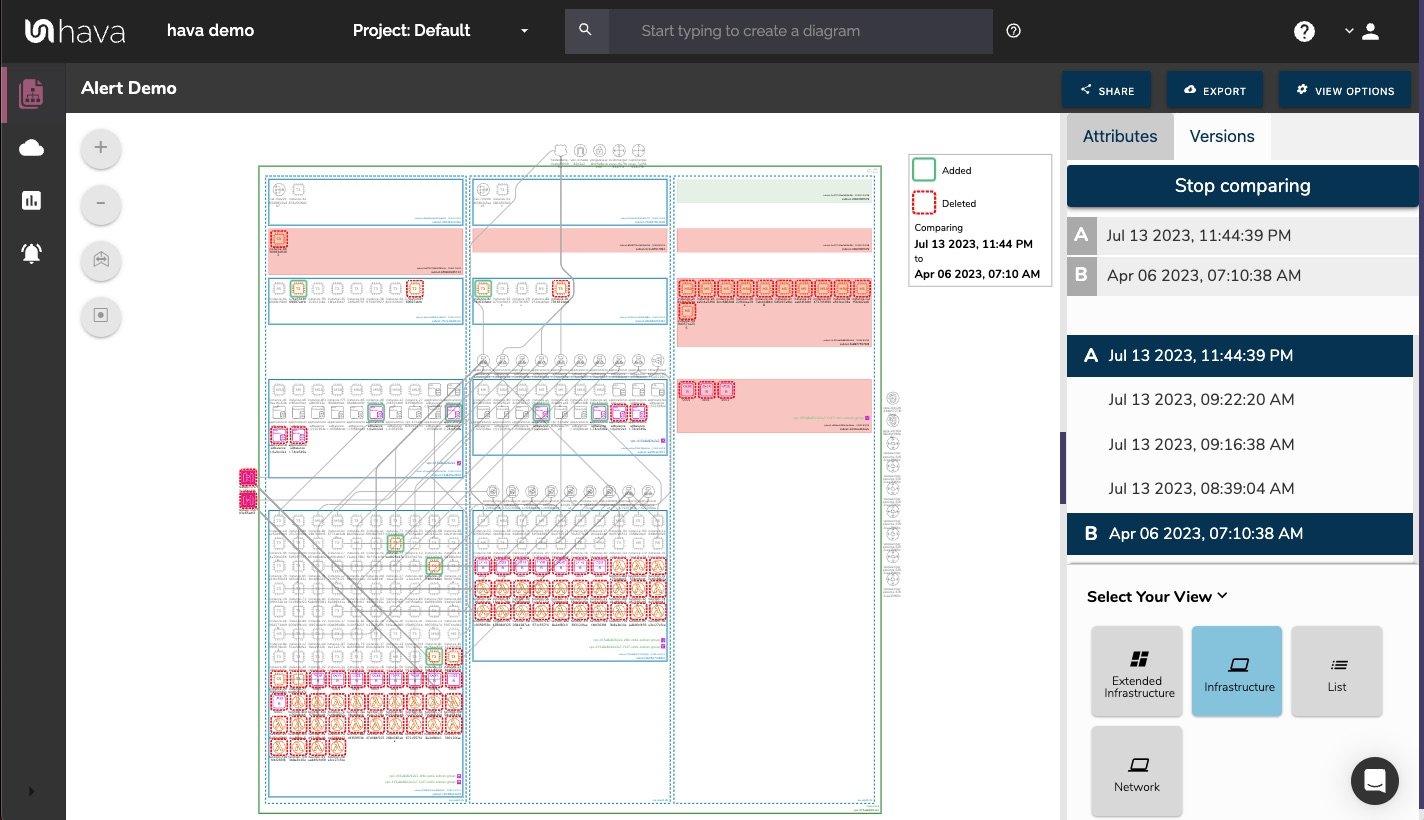
The built in architecture monitoring alerts will notify you whenever something changes. Whenever a change is detected, Hava sends you an email alert and a diff diagram highlighting the changes so you can see both physically and contextually what changed. With ChatOps integration coming soon, there isn't an easier way to stay on top of your cloud infrastructure than using Hava as your monitoring solution.
From understanding the significance of cloud monitoring to exploring the best cloud monitoring tools of 2024, this guide has covered the essentials of maintaining robust and secure cloud-based operations. Whether it’s leveraging real-time analytics, integrating machine learning, managing multi-cloud environments, ensuring security, or optimizing performance, the right cloud monitoring tool can significantly enhance your IT operations. As businesses continue to rely heavily on cloud services, employing effective cloud monitoring strategies is more crucial than ever.
A Cloud Monitoring tool helps organizations ensure the performance, availability, and security of their services and digital touchpoints, providing real-time visibility and proactive monitoring to identify and fix issues before they impact the end-user experience.
The best cloud monitoring tool is subjective and depends on your specific needs, but some popular options include New Relic, Dynatrace, and Netdata Cloud. Try to assess your requirements and compare these tools to make an informed decision. If you want an easy and simple solution check out Hava's architecture monitoring alerts.
The equivalent of CloudWatch in GCP is Google Cloud Operations Suite, formerly known as Stackdriver. It offers monitoring, logging, and diagnostics tools to manage Google Cloud resources effectively.
Cloud monitoring is crucial for maintaining the health and performance of cloud-based applications and infrastructure, enabling organizations to proactively identify and resolve issues and ensuring a smooth end-user experience. It involves the assessment and management of cloud-based IT infrastructures and services.
Real-time analytics in cloud monitoring help teams anticipate and address failing components, service spikes, and security threats, leading to swift issue resolution and reduced impact on customers and business operations.
If you are building cloud architecture on AWS, GCP or Azure we invite you to check out Hava. Follow the learn more button below to find out about:
Troubleshooting cloud computing issues can be time consuming and complex. Here's how Hava can help.
AWS Cloud Map and Hava cloud mapping to architecture diagrams are two very different things. In this article we take a look at the two solutions and...
With Hava's free tier, you can connect either an AWS, Azure, GCP or Kubernetes data source and automatically generate cloud network diagrams for free.